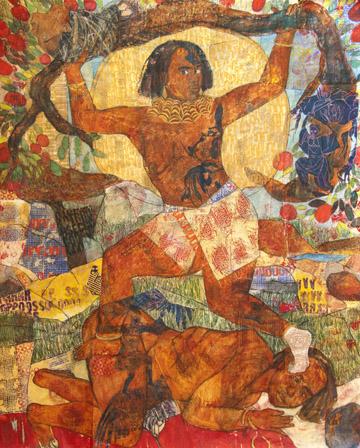‘Portraiture Now’ at the National Portrait Gallery
By • January 17, 2013 0 1823

Over thousands of years, portraiture has taken on a history and life of its own. In Egypt and other ancient societies, portraits of gods and rulers were ubiquitous. Though no examples remain today, ancient Greek painting is known to have developed a highly accurate portrait style, the evidence remaining in sculpted Hellenistic portrait busts of emperors and historical personalities from Alexander the Great to Socrates. By the zenith of the Roman Empire, portraiture had absorbed and propelled Greek and Etruscan traditions with artistic advancements and imbued them with senatorial political currents and religious and ancestral usage.
Skip ahead a few 1,000 years, past the Renaissance and the Dutch masters, the dreamy exuberance of the Baroque, the self-aggrandizing methodology of the Enlightenment and the emotional revolt of the Romantics, through roiling, ungodly tides of Impressionism—throw the invention of the personal camera and the cinematograph in there somewhere—and over the Vienna Secession, Cubism, Surrealism, Abstract Expressionism, Post-Modernism, Warhol, Conceptualism, and into the thick of the Information Age, where the plugged-in masses can cast their picture-phone portraits into a depthless technological sea as quickly and frequently as they can take them.
So, considering as many things up to this point, I often wonder what a drawn or painted portrait has to do with anything anymore. It can feel like a stuffy tradition, as dated as muskets and cravats, most often employed as an exercise by art students or as social posturing by royal families and self-important dignitaries. Frankly, compared with a good photographic portrait, a fine art portrait today looks a little awkward, out of place and self-conscious (Did anyone catch the recent Kate Middleton portrait fiasco?).
“Portraiture Now: Drawing on the Edge,” at the National Portrait Gallery, takes on the challenge of portraiture’s fate, pulling together a collection of contemporary artists who are moving the subject forward with fresh relevance. The artists featured in this exhibit use both timeless and modern techniques to deal with portraiture’s historical baggage as well as its inherently personal nature, presenting a cross-cultural smattering of identities and legacies for our time. The artists explore who we are and who surround us, where we come from and where we might go, and grapple with rendering the likeness of a broader, more disparate society that can no longer be cleanly identified.
Mequitta Ahuja is an African American and South Asian artist born in Grand Rapids, Mich. Her self-portraits are large, colorful fusions of her religious and cultural backgrounds, which she patches together to create her own personal history. It is a series of expansive, quilt-like canvases, which look as if they grew organically as more space was needed, cluttered with stamps, marks and washes of color. She places herself in the center of the compositions, surrounded by vaguely mythological plants, cryptic hieroglyphics, and a variety of symbolic markers from Eastern and Western traditions. Collectively, the works are enchantingly amorphous, offering a singular portrait of one woman’s bold emergence from her wild and untamed heritage.
The small, uniform, nearly translucent graphite portraits by Rob Matthews are on the opposite end of the spectrum from Ahuja’s self-portraits. With a softness and precision of light that recalls Vermeer and an unsettling emotional hollowness, Matthews renders meticulously detailed graphite drawings of his friends and family that consecrate the mundane affectations of our lives. His subjects each hold an object, a reference to medieval saints, but in place of bibles, swords or quills, they hold basketballs, crocheted skulls, house cats and turntables. The blank, distant stares of his portraits are like an acceptance of mortality, and the portraits turn into odd memorials of the “pre-deceased.”
Like Matthews, Ben Durham makes portraits of the people from his hometown, though he is further distanced from his subjects. Born in Lexington, Ky., he derives his source material from the local police blotter. These are people he knew in his childhood, some now arrested for traffic violations, others for assault or murder. Durham writes out his memories of them on thick handmade paper, using the mug shots as guidelines for his words. As he reconstructs his memories, a portrait composed of entirely handwritten text emerges. The clarity of the portraits are stunning, but the effect of a written story rendered unreadable from physically running over itself is an altogether beautiful sensation. Without being overwrought, these works pose the eternal question of what it is that defines each one of us, and illuminate the inescapable ripple effects of our past.
Adam Chapman’s digital works do not privilege the finished artwork over the pieces of it. His digital animations aggregate 150 of his own portrait sketches, and proceed to pull and push about their disassembled elements of line and shape on an LED screen. The moving pieces float in and out of the screen, occasionally and briefly reformulating into one of the portraits. Chapman custom-built the software, and according to the artist’s statement, every second of the installation is original, and every time a portrait is formed it is altered, shifted in some way from its initial incarnation. The portraits are continually forming, dissolving and reforming, sometimes without coming together at all. Like moments of clarity amidst the overwhelming malaise of a waking life, only briefly do the mechanics of the world flash brilliantly into focus.
So, what does portraiture have to do with anything anymore? Perhaps nothing. But if we take the time and exert the effort, it can offer us perspectives on our own lives that ultimately define the way we experience things—from our relationships with friends and family, to the effects our past, to the small rituals we unknowingly create to help us through our lives. Surely it is worth a look.
“Portraiture Now: Drawing on the Edge,” is at the National Portrait Gallery through Aug. 18. For more information, visit www.npg.si.edu

